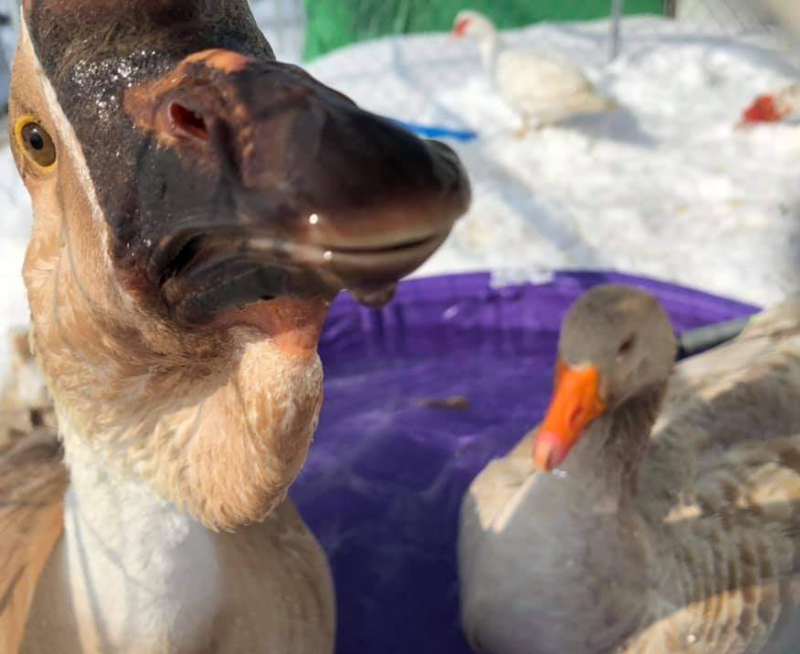
If you spend much time on sanctuary grounds, you likely know that residents have complex and fascinating personalities and quirks. Because many folks have likely never met individuals living out their lives in sanctuary before, we have created a series of resources compiling fun and fascinating facts about residents to share with supporters and the general public. Geese are amazing beings who deserve to be better known!
Fun Facts About Geese
- Geese have impressive visual capabilities! The way their eyes are structured allows them to see things in much finer detail at a further distance than humans!
- As if that wasn’t cool enough, they can also see UV light- this helps geese see the world in a vastly different way than we do!
- Goose vision doesn’t stop there- they also have the ability to control each of their eyes independently!
- Along with this ability, geese are able to literally sleep with one eye open! They can shut down one half of their brain to rest, and can even adjust how deeply they sleep by how wide their eye is open or closed!
- While many geese may look quite similar to us, they can identify other individuals in their flock, and goslings can distinguish between their siblings quite well!
- Geese are attuned to the experiences of others around them! It’s been determined that the heart rate of geese increases when they see their companion or family members in conflict with another goose.
- The bills of geese are sensitive with many touch receptors, similar to those in our fingertips and palms.
- Young geese will react to the odors of different plants quickly after being born. In fact, when offered scents of plants that adult geese don’t eat (such as lavender or violet), they will shake their heads, but when they are a bit older, they will act quite differently to the scents of plants that adults consider edible!
- Starting at an early age, geeseUnless explicitly mentioned, we are referring to domesticated goose breeds, not wild geese, who may have unique needs not covered by this resource. are able to follow the gaze of others, giving them important information about predators, resources, and social interactions! Have you ever noticed your friend turn their head and look into the distance? You most likely turn to see what they are looking at. Geese do this too!
- Little goslingsYoung geese start communicating with their parents while they are still in their eggs! How’s that for a parent child relationship?
Hopefully this gives you and your visitors a better idea about the complex and fascinating lives of geese. Did you find any of these fun facts surprising? Or would you like to see a verified fun goose fact added to this list? Let us know!
SOURCES:
Early Development Of Gaze Following Into Distant Space In Juvenile Greylag Geese (Anser Anser) | Animal Cognition (Non-Compassionate Source)
Juvenile Greylag Geese (Anser Anser) Discriminate Between Individual Siblings | PLOS One (Non-Compassionate Source)
Juvenile Greylag Geese (Anser Anser) Discriminate between Individual Siblings | PLOS One (Non-Compassionate Source)
Understanding Waterfowl: The Five Senses | DucksUnless explicitly mentioned, we are referring to domesticated duck breeds, not wild ducks, who may have unique needs not covered by this resource..org (Non-Compassionate Source)
Olfaction And Feeding Behaviour in Juvenile Geese (Anser A. Anser And Anser Domesticus) | Ethology (Non-Compassionate Source)
DuckUnless explicitly mentioned, we are referring to domesticated duck breeds, not wild ducks, who may have unique needs not covered by this resource. Bill’s Sensitive Touch Develops In The Egg | Science Mag (Non-Compassionate Source)
Heart Rate Modulation In Bystanding Geese Watching Social And Non-Social Events | The Royal Society (Non-Compassionate Source)
A Bird’s-Eye View | Ducks.org (Non-Compassionate Source)
How do birds sleep? | Audubon (Non-Compassionate Source)
If a source includes the (Non-Compassionate Source) tag, it means that we do not endorse that particular source’s views about animals, even if some of their insights are valuable from a care perspective. See a more detailed explanation here.








